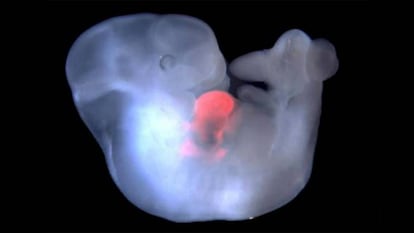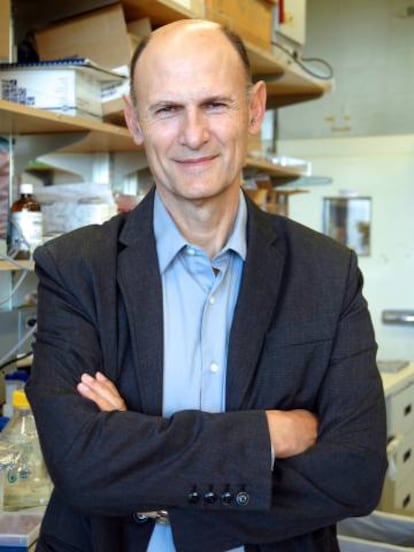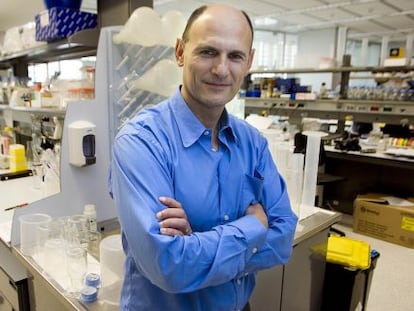Spanish scientists create human-monkey chimera in China
The team led by Juan Carlos Izpisúa injected stem cells into the animal embryos as part of research aimed at finding a way to grow organs for transplants

Researchers led by Spanish scientist Juan Carlos Izpisúa have created for the first time a human-monkey hybrid in a laboratory in China – an important step towards using animals for human organ transplants, project collaborator Estrella Núñez confirmed to EL PAÍS.

The team, made up of members of the Salk Institute in the United States and the Murcia Catholic University (UCAM) in Spain, genetically modified monkey embryos to deactivate genes that are essential to the formation of organs. The scientists then injected human stem cells, which are capable of creating any type of tissue, into the embryo. The product of this work is a monkey with human cells that has not been born, because researchers stopped the process.
“The results are very promising,” says Núñez, a biologist and vice chancellor of research at UCAM. The team has not provided more details because they are waiting to publish their findings in an internationally renowned scientific journal. “From UCAM and the Salk Institute we are now trying not only to move forward and continue experimenting with human cells and rodent and pig cells, but also with non-human primates,” explains Izpisúa. “Our country is a pioneer and a world leader in these investigations,” he adds.
Izpisúa, born in Hellín (Albacete) in 1960, says that in 2017 his team conducted “the first experiment of human and pig chimeras in the world,” although with less success. “The human cells did not take hold. We saw that they contributed very little [to the development of the embryo]: one human cell for ever 100,000 pig cells,” says the Argentinean veterinarian Pablo Ross, a researcher from the University of California at Davis and a co-author of that experiment.
The results are very promising
Biologist Estrella Núñez
Izpisúa’s team has been able to create chimeras between more similar species, for instance the rat and the mouse, which is five times closer than humans and pigs. In 2017, the researchers also used the revolutionary genome editing tool CRISPR to deactivate genes in mouse embryos that are fundamental to the development of the heart, eyes and pancreas. The team then introduced rat stem cells that were capable of generating these organs. The result was a series of rat-mouse chimera embryos, whose gestation was also stopped in accordance to the international consensus regarding these types of experiments.
Doctor Ángel Raya, the director of the Barcelona Regenerative Medicine Center, explains that experiments with chimeras face “ethical barriers.” “What happens if the stem cells escape and form human neurons in the brain of the animal? Would it have consciousness? And what happens if these stem cells turn into sperm cells?” he asks. Núñez assures that Izpisuá’s research team has created mechanisms “so that if human cells migrate to the brain, they will self-destruct.”
Chimeras
The name comes from Greek mythology, which described monstrous creatures that were part dragon, part goat, part lion. Today's chimeras are organisms that contain cells from two different species.
To avoid ethical issues, the scientific community has traditionally set the “red line at 14 days” of gestation, says Raya, which is not enough time for the embryo to develop a human central nervous system. All chimera embryos are destroyed before that period expires. “In no case is the gestation brought to full term,” adds Núñez.
Izpisúa’s research with monkeys in China was financed in large part by the UCAM, and did not come cheap. “If we combine the human/pig, human/rat and human/monkey research, it is many hundreds of thousands of euros,” says Núñez.
In Spain, this type of research is heavily restricted and limited only to investigation into deadly diseases. “We are doing the experiments with monkeys in China because, in principle, they cannot be done here because of lack of infrastructure,” explains the vice chancellor, who plays down the fact that her university is Catholic. “What we want is to make progress for the sake of people who have a disease,” she adds. Núñez underlines that the Spanish ethical committees approved the experiment of human and pig chimeras in Murcia in 2017.
“The ultimate goal would be to create a human organ that could be transplanted, but the path itself is almost more interesting for today’s scientists,” says Núñez. “I am essentially aware that I will not see it happen [the development of human organs in animals] but to arrive at that point, it’s necessary to pass through this one.”
English version by Melissa Kitson.
Tu suscripción se está usando en otro dispositivo
¿Quieres añadir otro usuario a tu suscripción?
Si continúas leyendo en este dispositivo, no se podrá leer en el otro.
FlechaTu suscripción se está usando en otro dispositivo y solo puedes acceder a EL PAÍS desde un dispositivo a la vez.
Si quieres compartir tu cuenta, cambia tu suscripción a la modalidad Premium, así podrás añadir otro usuario. Cada uno accederá con su propia cuenta de email, lo que os permitirá personalizar vuestra experiencia en EL PAÍS.
¿Tienes una suscripción de empresa? Accede aquí para contratar más cuentas.
En el caso de no saber quién está usando tu cuenta, te recomendamos cambiar tu contraseña aquí.
Si decides continuar compartiendo tu cuenta, este mensaje se mostrará en tu dispositivo y en el de la otra persona que está usando tu cuenta de forma indefinida, afectando a tu experiencia de lectura. Puedes consultar aquí los términos y condiciones de la suscripción digital.
More information
Archived In
Últimas noticias
Most viewed
- Alain Aspect, Nobel laureate in physics: ‘Einstein was so smart that he would have had to recognize quantum entanglement’
- Alvin Hellerstein, a 92-year-old judge appointed by Bill Clinton, to preside over Maduro’s trial in New York
- Gilles Lipovetsky: ‘If you want to live better and fall in love, take Prozac, don’t look to philosophy’
- Cuba confirms death of 32 of its citizens in the US attack against Venezuela
- Why oil has been at the center of Venezuela-US conflicts for decades











































